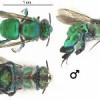On May 29, 2015, the EPA published its Proposal to Mitigate Exposure to Bees from Acutely Toxic Pesticide Products. This seven-page fact sheet outlines the highlights from this policy and its proposed restrictions, which would prohibit applications of pesticide products that are acutely toxic to bees during bloom where honey bees are known to be present under contract for pollination services. Written by Frederick M. Fishel, James Ellis, and Gene McAvoy and published by the Agronomy Department.
edis.ifas.ufl.edu/pi271
Tag: Wasps and Bees
Green orchid bee Euglossa dilemma Friese (Insecta: Hymenoptera: Apidae)
 Green orchid bees are a quite conspicuous and charismatic species. This is mostly due to their large size and bright metallic-green coloration. They are very fast and agile flyers, and can be seen quickly darting from flower to flower separated by long periods of hovering. Male orchid bees collect fragrant volatile compounds from their environment and present them to females by fanning their wings and “spray ventilating” their bouquet for the inspection of prospective mates. In Florida, male green orchid bees are attracted to chemicals produced by certain wood-rot fungi, decomposing vegetation, perfume flowers, and certain essential oils such as clove and cinnamon oil. Male green orchid bees can be quickly and easily attracted and observed by soaking a small piece of paper with clove oil and placing it outside. This 4-page fact sheet was written by Aaron Mullins, and published by the UF Department of Entomology and Nematology, October 2013.
Green orchid bees are a quite conspicuous and charismatic species. This is mostly due to their large size and bright metallic-green coloration. They are very fast and agile flyers, and can be seen quickly darting from flower to flower separated by long periods of hovering. Male orchid bees collect fragrant volatile compounds from their environment and present them to females by fanning their wings and “spray ventilating” their bouquet for the inspection of prospective mates. In Florida, male green orchid bees are attracted to chemicals produced by certain wood-rot fungi, decomposing vegetation, perfume flowers, and certain essential oils such as clove and cinnamon oil. Male green orchid bees can be quickly and easily attracted and observed by soaking a small piece of paper with clove oil and placing it outside. This 4-page fact sheet was written by Aaron Mullins, and published by the UF Department of Entomology and Nematology, October 2013.
http://edis.ifas.ufl.edu/in1013
Miner Bee, Chimney Bee Anthophora abrupta Say (EENY512/IN912)
 These gregarious, yet solitary, ground-nesting bees are “…conspicuous as they noisily swing their ponderous bodies to and fro on the wing, arrive home and scramble into their burrows or come tumbling out headlong and dash off into the sunny fields, with all the exuberance of boys just out of school.” This 5-page fact sheet was written by Jason R. Graham, Jamie Ellis, Glenn Hall, and Catherine Zettel Nalen, and published by the UF Department of Entomology and Nematology, December 2011.
These gregarious, yet solitary, ground-nesting bees are “…conspicuous as they noisily swing their ponderous bodies to and fro on the wing, arrive home and scramble into their burrows or come tumbling out headlong and dash off into the sunny fields, with all the exuberance of boys just out of school.” This 5-page fact sheet was written by Jason R. Graham, Jamie Ellis, Glenn Hall, and Catherine Zettel Nalen, and published by the UF Department of Entomology and Nematology, December 2011.
http://edis.ifas.ufl.edu/in912
The Bumble Bees of Florida, Bombus spp. (EENY050/IN207)
 Bumble bees are easily recognized by the corbicula (pollen basket) on the hind tibiae in the females. They are beneficial insects that pollinate many native and ornamental plants. They can sting severely, so problem nests near human dwellings should be removed by experienced pest control operators. This 5-page fact sheet includes a key to the bumble bees in Florida. Written by Lionel A. Stange, and published by the UF Department of Entomology and Nematology, December 2011.
Bumble bees are easily recognized by the corbicula (pollen basket) on the hind tibiae in the females. They are beneficial insects that pollinate many native and ornamental plants. They can sting severely, so problem nests near human dwellings should be removed by experienced pest control operators. This 5-page fact sheet includes a key to the bumble bees in Florida. Written by Lionel A. Stange, and published by the UF Department of Entomology and Nematology, December 2011.
http://edis.ifas.ufl.edu/in207
Sweat Bees, Halictid Bees, Halictidae (Insecta: Hymenoptera: Halictidae) (EENY499/IN897)
 Sweat bees are very important pollinators for many wildflowers and crops, including stone fruits, pomme fruits, alfalfa and sunflower. Sweat bee populations can be encouraged with wildflower plantings and by providing nesting areas. Halictids typically nest in bare soil located in a sunny location. Minimum tillage and insecticide use will help to increase populations of Halictidae and other soil nesting bees. Learn more about this diverse family of bees in this 5-page fact sheet was written by Katie Buckley, Catherine Zettel Nalen, and Jamie Ellis, and published by the UF Department of Entomology and Nematology, August 2011.
Sweat bees are very important pollinators for many wildflowers and crops, including stone fruits, pomme fruits, alfalfa and sunflower. Sweat bee populations can be encouraged with wildflower plantings and by providing nesting areas. Halictids typically nest in bare soil located in a sunny location. Minimum tillage and insecticide use will help to increase populations of Halictidae and other soil nesting bees. Learn more about this diverse family of bees in this 5-page fact sheet was written by Katie Buckley, Catherine Zettel Nalen, and Jamie Ellis, and published by the UF Department of Entomology and Nematology, August 2011.
http://edis.ifas.ufl.edu/in897
